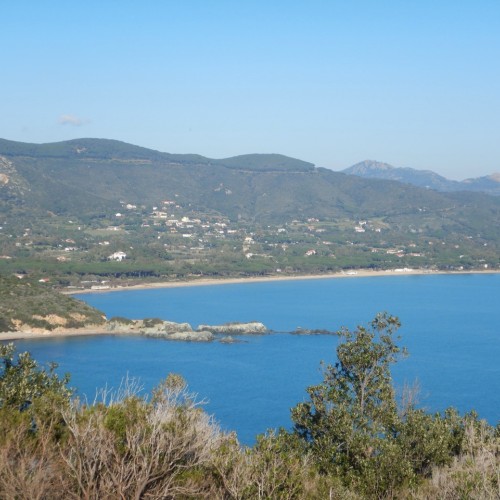
Lacona beach is one of the best-known on the Island of Elba. Also known as Spiaggia Grande ('big beach'), stretching for 1.2 km, it is second only to Marina di Campo beach (1.6 km) and is frequented and loved by tourists and islanders alike. Punta della Contessa, an outcrop of serpentine metamorphic rock separates this large beach, to the west, from the bay of Laconella, with its distinctive Omaccio, a rock formation shaped like a big man. The sand is fine and golden-yellow, originating from breakdown of porphyry together with limestone and sandstone from the nearby hills.
Above the sea shore, there is a broad plateau traditionally used for agriculture. This plain, sloping slightly from the base of the hills towards the sea, is still partially cultivated, while much of the Lacona area is now occupied by numerous accommodation facilities which, during the summer season, host the numerous tourists attracted by the beautiful beach and landscape of this place. Since the 1960s, many campsites, hotels and restaurants have sprung up, now accompanied by other infrastructures and services for the thousands of visitors who choose this area for their holidays. In some photographs from the late 1960s, the beach and the countryside behind it appear barer than today and almost devoid of trees. There were few pines then, while the strip of dunes and retro-dunes covered with pioneer flora and low Mediterranean maquis was almost untouched. Here, in the wild beauty of this almost unreal setting between land and sea, the first campers arrived in the 1950s.
Today, these dunes - tiny patches compared to the expanses of the Atlantic dunes or those of the continental Mediterranean coasts - are subject to considerable human pressures, so the National Park has taken action by purchasing the now remaining area in order to safeguard its biodiversity. A group of pioneer plants continues to colonise the drifts of sand shaped by the wind. These small plants - herbaceous species or, at most, small subshrubs - hold the sand together with their roots, reducing wind erosion and preparing the ground for taller future vegetation. This particularly adaptable flora offers interesting opportunities to study natural selection and environmental evolution and, especially during the spring and summer months, regales us with spectacular blossoms.
The characteristics of these particular species are extreme resistance to summer dryness and heat and to the strong winds carrying salty sea spray, together with their ability to adapt to loose soil low in organic substances. These small plants include cottonweed, sea clover, prickly parsnip, sea holly, sea rocket, sea chamomile, sea daffodil and beach morning glory, and we should take care not to trample on them as we approach the sandy shores.




